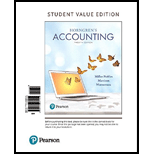
Concept explainers
Concept Introduction:
Differential analysis: Differential analysis is a cost analysis method in which two or more alternative business decisions are compared with each other to find out the best alternative decision. Under this approach only relevant costs of underlying business decision are taken into consideration and suck cost is ignored.
Relevant Cost: Relevant cost is the incremental and inevitable cost that is incurred when making a specific business decision. Relevant cost is useful in eliminating unrequited data that makes decision making process complex.
Irrelevant Cost: Irrelevant cost is the cost that will remains unchanged as a result of specific business decisions
1.
To Prepare: The differential analysis to show whether Security Team should drop the industrial system product line or not.
2.
To Prepare: The contribution margin income statement for total operating income under the two alternatives given in question and compare the difference with the answer of requirement 1.
3.
To Explain: The learning from the comparison in requirement 2.
Want to see the full answer?
Check out a sample textbook solution
Chapter 25 Solutions
Horngren's Accounting, Student Value Edition (12th Edition)
- Sierra Tech Industries purchased an asset costing $80,000 that is expected to produce 600,000 units and have a salvage value of $8,000. In the first year, 100,000 units are produced; in the second year, 95,000 units are produced; and in the third year, 88,000 units are produced. Using the units-of-production method, what is the book value of the asset at the end of year 3?arrow_forwardWaka Company had cash sales of $78,275, credit sales of $97,450, sales returns and allowances of $1,500, and sales discounts of $4,875. Calculate Waka's net sales for this period.arrow_forwardProvide answerarrow_forward

 AccountingAccountingISBN:9781337272094Author:WARREN, Carl S., Reeve, James M., Duchac, Jonathan E.Publisher:Cengage Learning,
AccountingAccountingISBN:9781337272094Author:WARREN, Carl S., Reeve, James M., Duchac, Jonathan E.Publisher:Cengage Learning, Accounting Information SystemsAccountingISBN:9781337619202Author:Hall, James A.Publisher:Cengage Learning,
Accounting Information SystemsAccountingISBN:9781337619202Author:Hall, James A.Publisher:Cengage Learning, Horngren's Cost Accounting: A Managerial Emphasis...AccountingISBN:9780134475585Author:Srikant M. Datar, Madhav V. RajanPublisher:PEARSON
Horngren's Cost Accounting: A Managerial Emphasis...AccountingISBN:9780134475585Author:Srikant M. Datar, Madhav V. RajanPublisher:PEARSON Intermediate AccountingAccountingISBN:9781259722660Author:J. David Spiceland, Mark W. Nelson, Wayne M ThomasPublisher:McGraw-Hill Education
Intermediate AccountingAccountingISBN:9781259722660Author:J. David Spiceland, Mark W. Nelson, Wayne M ThomasPublisher:McGraw-Hill Education Financial and Managerial AccountingAccountingISBN:9781259726705Author:John J Wild, Ken W. Shaw, Barbara Chiappetta Fundamental Accounting PrinciplesPublisher:McGraw-Hill Education
Financial and Managerial AccountingAccountingISBN:9781259726705Author:John J Wild, Ken W. Shaw, Barbara Chiappetta Fundamental Accounting PrinciplesPublisher:McGraw-Hill Education





